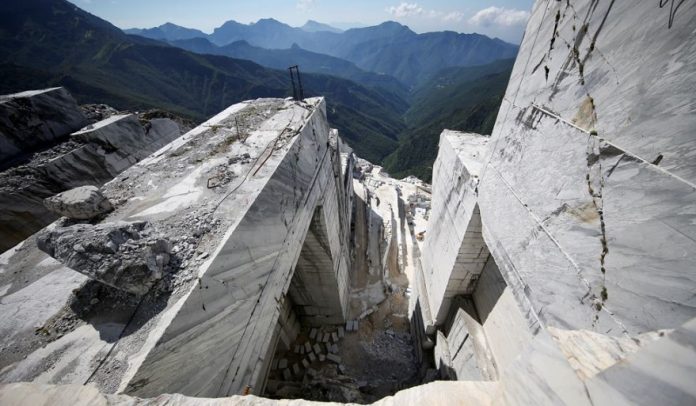Five hundred years ago, Pope Leo X forced Michelangelo to leave his beloved Carrara and find new quarries in the impenetrable surroundings of Pietrasanta and Seravezza to extract marble for the façade of Florence’s San Lorenzo Basilica. Michelangelo strenuously opposed the papal decision, not seeing the point in changing suppliers. But Leo X, was resolute: Carrara marble came at a cost, while the Pietrasanta area was controlled by Florence, so the rock was free. It came at a high price for the artist who, already a sculptor, painter and architect, now had to improvise as quarryman and road builder too. If marble was to be found in the mighty Monte Altissimo overlooking Seravezza, it was not easy to get it.
Michelangelo spent three years climbing, exploring and taming the harsh mountainsides. He unearthed white veined Statuario marble on Monte Altissimo and began building a road to the sea so that it could be shipped to Florence. Years later, Grand Duke Cosimo I guessed the potential of the area, building a beautiful villa in Seravezza, completing the Michelangelo road from Monte Altissimo to Forte dei Marmi and paving the way for the marble industry in Versilia.
500 years have passed since Michelangelo forged his marble road, extending from Seravezza to the heel of the Trambiserra and Cappella quarries. One of the many roads crossing the Apuan Alps, it is imbued with a legacy that has shaped the character of all towns in Alta Versilia.
It’s the marble memory of Michelangelo that makes the strongest impact. During his time in the area, Michelangelo laid out the design of a rosette for the Azzano Chapel, a Romanesque pieve that regally overlooks Versilia. Now known as the Eye of Michelangelo, this rosette “gazes” outward onto the many young, international artists who arrive here every summer to carve, study and breathe in the air of centuries-old chestnuts and millenary marble.
Each century after Michelangelo saw its own developments. Most notable for the 1600s was the takeoff of square marble tile production. In the 18th century, marble blocks were sent down the Michelangelo-blazed path by cableways and ropeways, then were loaded on ox-led carriages and brought to the seaside where they would be shipped. This modus operandi continued well into the early years of the 1900s, but by the 1960s, the Cappella quarries no longer had marble to offer.
This had little effect on the legions of artisans and artists who continue to carve out creative space here, keeping the “memory of marble” alive. A vibrant community of foreign-born artists charges on in the many schools and workshops of Pietrasanta, while Seravezza treasures the legacy of the greatest sculptor to ever give body and soul to stone.
Today, the road is no longer used for transporting marble, but at the Azzano Chapel, overlooking the Versilia coast and the Apuan outline in the distance, one can still hear the marble being chiselled against the silence of the valley.
Source: theflorentine.net










































